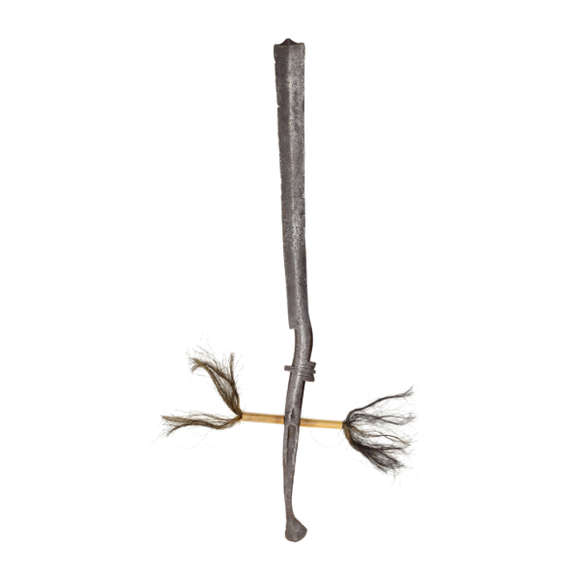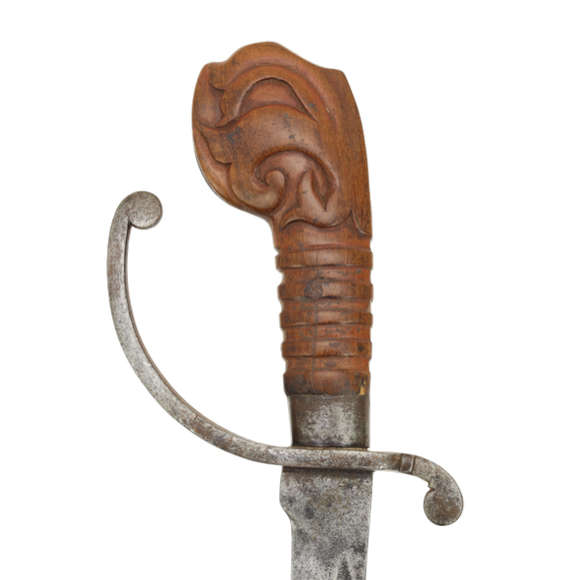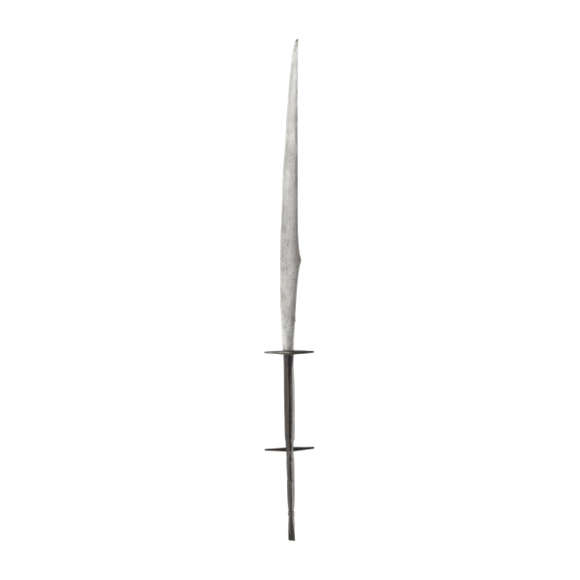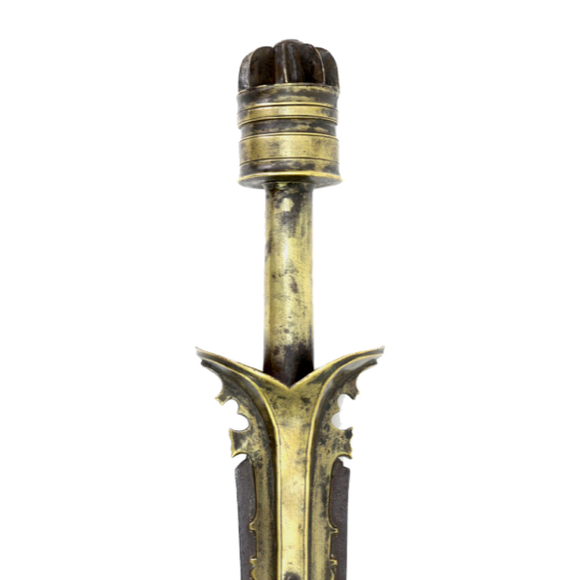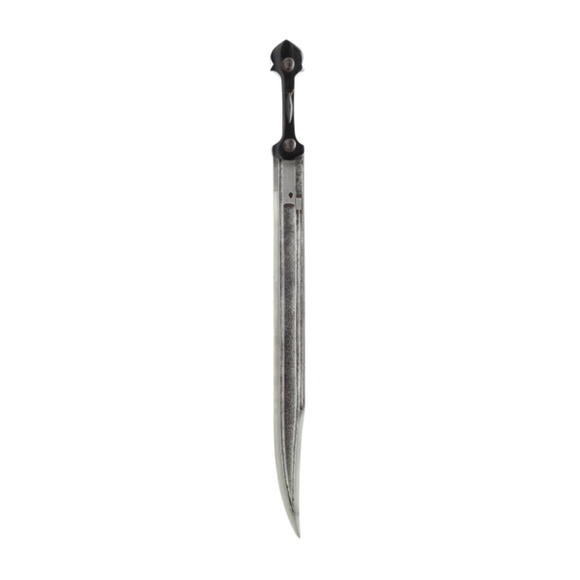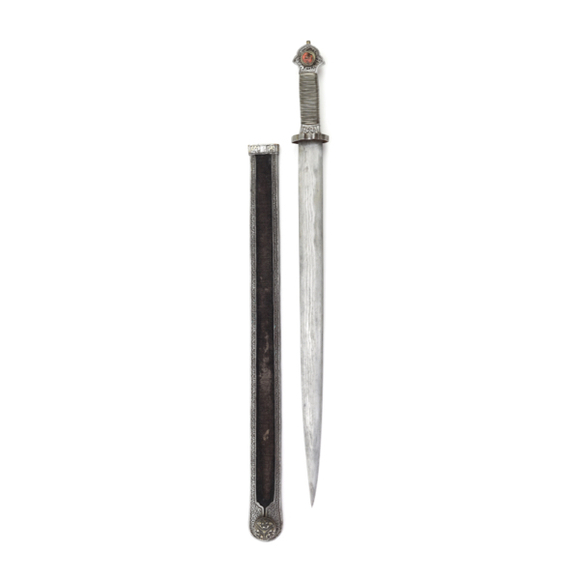This peculiar sword was used by the Garo people of Assam for fighting, clearing the jungle, and animal…

Sheathed 69 cm
Sword 66.2 cm
52.1 cm
Base 8 mm
Middle 7 mm
5 cm from tip 5 mm
Base 30 mm
Middle 28 mm
5 cm from tip 26.5 mm
545 grams
16.1 cm from hilt
Iron, steel, wood, brass, copper, lacquer.
Taiwan
19th century
Description
An unusual piece that leaves myself and various Taiwan experts puzzled.
It is built around a straight blade with a parallel edge and back, known in Chinese as zhíbèidāo (直背刀) or "straight spine knife", an archaic blade form that fell out of use in China itself around the Yuan dynasty. Cultures at the fringes ot the empire, mainly Sichuan, Tibet, Yunnan, and Taiwan retained straight swords for much longer.
The blade is forge folded with a separate high-carbon edge plate, as also common on the swords of China. It also shows faint signs of differential heat treatment in the form of cloudy effects near the edge. The blade has an unusual asymmetric cross-section with a flat blade on the left side and a pronounced ridge just under the spine on the right side.

The scabbard's mouth illustrates the unusual cross-section of the blade.
Hilt
The sword is hilted with a piece of very dense brown wood. It goes from a hectagonal cross-section at the pommel to a round cross-section at the top. It is reinforced with a brass ferrule. The pommel is capped with a Chinese coin, covered by an iron washer.
The pommel is carved with a tager face on each facing side. We know it is a tiger because the character wáng (王) features prominently on its forehead. In the Chinese culture, tigers are seen as protective deities. In mandarin, the word for tiger, hū (虎) has the same pronunciation as the word for protection, hū (護). Tigers feature as protective talismans on children's hats and als often on the faces of (rattan) shields.
The rest of the hilt is carved with bands of decorative motifs including stylized rolling thunder, looking much like the European "greek key" pattern and a band of lucky coins/flowers. It is further decorated with a number of brass nails with tiny brass washers, four of them serve as eyes for the two tiger faces. There is a depression in the hilt that once may have held a metal band.

The hilt with tiger face.
Scabbard
The scabbard is every bit as unusual as the rest of the piece. It is made of two halves of wood, joined together by three bands of blackened brass. The top of the scabbard is carved with the head of a dragon with a sphere in its jaws. The sphere represents the rúyì zhū (如意珠) or "wish-granting jewel". Dragons are often depicted in art as merely chasing such pearls, rarely do they manage to grasp it.
The middle section of the scabbard is carved with four windows, cut through to expose the blade, and decorated with scenes depicting birds and flowers. Notable among the flowers are plum, which symbolize perseverence and purity. It is also a symbol of passing the first of the civil examinations.1
On the reverse, four cartouches are carved that each contain one of the Sìyì (四藝) or "Four Scholarly Pursuits"; qín (琴) qí (棋) shū 書 huà (畫); the zither, chess, books and paintings respectively.2
The very tip of the scabbard is carved with the outline of a Chinese scabbard mount typically found on jiàn, the Chinese straightsword that was associated with the scholar class. It also contains a tàijí (太極) symbol, symbolizing the opposing universal forces of yīn ( 陰) and yáng (陽).
There is a brass ring for suspension on the apex of the dragon's nose.
Condition
The piece has undergone some repairs. Scabbard was broken and repaired, splits and missing pieces replaced. The handle was split due to shrinkage over the wood, beeswax was applied in the crevices of the hilt to mask them somewhat, a reversible touchup. Blade with edge damage, possibly from action. The hilt probably once had a metal band, now missing.
Conclusion
A most unusual and probably unique Taiwanese shortsword. The windows in the scabbard and octagonal cross-section hilt hint towards the Paiwan, who were also strongly influenced by Chinese culture. The artwork and symbolism refer to Chinese scholarly pursuits.
As a weapon, it doesn't feel anything like a showpiece. It has a hefty feel in the hand and a forward balance for considerable striking power. Various chips off the edge suggest active service.
A remarkable piece, most likely custom made for a discerning owner who stood firmly in between two cultures.
Notes
1. Terese Tse Bartholomew; Hidden meanings in Chinese art. San Francisco, Asian Art Museum, Chong-Moon Lee Center for Asian Art and Culture, 2006. Page 97.
2. Ibid.



















These mysterious weapons were already obsolete when the first ethnographers encountered them.
An early fighting piece with strong reinforcing langet and broad, cobra shaped tip.

